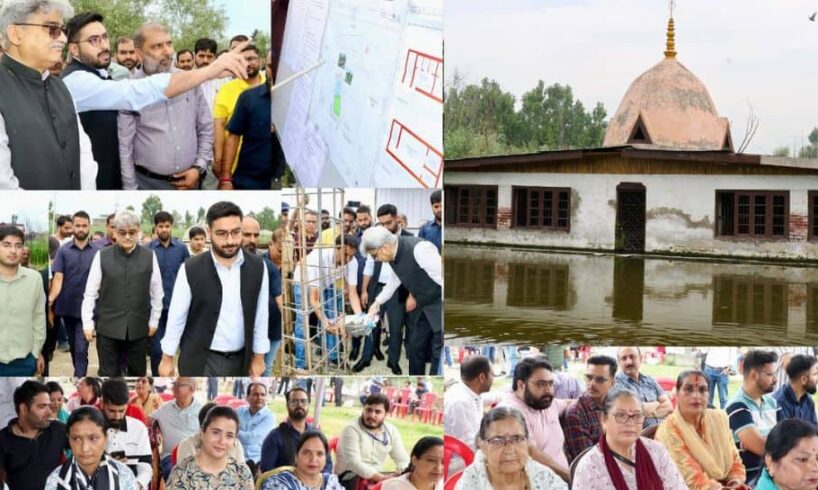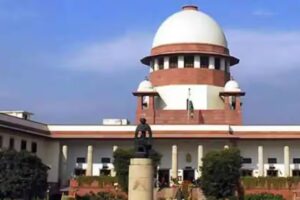
The renovation of the Vicharnag Temple in the old city of Srinagar is a significant project aimed at restoring a historic Lord Shiva temple, estimated to be around 2,100 years old. Located in the Nowshera area near Anchar Lake, the temple holds immense cultural, religious, and historical importance for the Kashmiri Pandit community and reflects Kashmir’s diverse heritage. The restoration work began on July 19, 2025, with the foundation stone laid by Chief Secretary Atal Dulloo and Deputy Commissioner Srinagar, Akshay Labroo.
Labour In-Charge Ajaz Ahmad Dar said, “Work has started for the past two days. We are 10-12 labourers working here. We are currently conducting soil tests. Many officers visited, and the inauguration was done. A new building will be constructed because the old one was damaged due to water. It will take 5–6 months to reconstruct the temple.”
Conservation and restoration of the two main Shiva temple structures will be done by lifting the structures with jacks to preserve the original architecture. The renovation includes earth-filling to restore the site’s original topography and the construction of an entry gate for aesthetic appeal. All construction will use traditional materials like ornamental wood and stonework to preserve the temple’s original aesthetics.
The temple complex includes five sacred springs and two ancient Shiva temples, historically significant as a place of religious discussions (Vichar), and visited by figures like Jagat Guru Shankaracharya.
The government has allocated approximately ₹4.58–₹5 crore for the project, which is being executed by the Roads and Buildings Department Srinagar under a heritage conservation scheme and the supervision of the Department of Archaeology, Jammu and Kashmir. The project is expected to be completed by July 2026.
Sartaj Ahmad Bhat, AEE of the Roads and Buildings Department, said, “We are reviewing the temple which is submerged. We are doing earth filling and constructing the gate and toilet blocks as well. The funding is from the Archaeology Department, and the executing agency is R&B Srinagar. We are lifting the temple with jacks so there will be no change in its structure. We are simply renovating it to retain its original architecture. The project has technical sanction of ₹4.5 crore and will be completed in one year. We are also undertaking construction of several other temples and mosques. This is a centuries-old temple, and we will also display its history on-site.”
The temple suffered significant damage during the terrorism in Kashmir over the past three decades, particularly following the mass migration of Kashmiri Pandits in the 1990s, which left it in disrepair. Vishwa Kashmiri Samaj, Zaara Foundation, and other prominent Kashmiri Pandit organizations have welcomed the restoration, emphasizing the need to rebuild the temple in its original glory while preserving its architecture.
History of the Temple
The Vicharnag Temple, also known as ‘Vichar Sahab,’ is mentioned in Kalhana’s Rajatarangini and is believed to have been the site of the 4th Buddhist Council during the reign of Emperor Kanishka (circa 78 CE). It was historically a center for religious and intellectual discussions, including debates among Kashmiri Brahmins on the Panchang, the Hindu calendar for the new year.
The temple is dedicated to Lord Shiva, with a prominent Shivalingam situated in a spring. It is believed to date back over 2,100 years, though exact construction dates remain uncertain.
The name “Vicharnag” comes from the Kashmiri and Sanskrit word Vichar, meaning discussion or thought, reflecting the temple’s historical role as a center of intellectual and spiritual discourse. Kashmiri Brahmins would gather at the temple to discuss the Panchang, and it is said that the revered philosopher Jagat Guru Adi Shankaracharya visited the temple for such discussions.
The temple is also believed to have been the site of the Fourth Buddhist Council (Sarvastivada tradition), convened by the Kushan Emperor Kanishka around 78 CE, reinforcing its role as a seat of learning in ancient Kashmir.
The main temple features a large spring, measuring 430 feet in length and 35 feet in breadth, with a 3-foot-high stone cylinder housing a Shivalingam at its center, visible only when the spring’s water level drops. The spring’s water is unique—ice-cold in summer and lukewarm in winter—and a variety of fish can still be seen in it.
One of the temples is built using chiseled and dressed devri stones, traditional to Kashmir, with stairs on the west and south sides of the spring, designed to face the morning sun. The site also includes a shrine dedicated to Goddess Parvati in her Annapurna manifestation, underscoring the temple’s ties to Kashmiri Shaivism.
The temple was once a hub for religious and socio-cultural activity. With Shaivism having deep roots in Kashmir, future religious planning was discussed here, especially during the Chaitra Amavasya festival, celebrated on the last day of the Kashmiri calendar. Devotees bathed in the holy spring and performed puja at the temple, referred to as “Vichar Sahab.”
The Vicharnag Temple remains a symbol of Kashmir’s pluralistic heritage, reflecting its past as a center of Hindu-Buddhist learning and Shaivite devotion. This restoration effort not only aims to restore a physical structure but also symbolizes a step toward cultural and spiritual revival for the Kashmiri Pandit community and the region’s rich history.
Ashok Kumar Karihaloo, a Pandit scholar, said, “It’s a very old temple, not hundreds but thousands of years old. It’s not Vacharnag, it’s Vichar Nag, a place where people sit and discuss. There is Lord Shiva’s Shivalingam inside the Vichar Nag and there are temples as well. A spring here has hot water in winter and cold water in summer. In early times, there was no printing, so learned Brahmins from north, south, east, and west of Kashmir would gather here and write the yearly calendar. On Amavasya, when the moon is born, those four groups would meet here, and whichever calendar matched would be finalized as the Panchang and distributed across locations. Adi Guru Shankaracharya visited this site around 800 years ago. It is a very pious place. What we celebrate on Amavasya used to be the celebration for the whole year. It’s a welcome step by the government. Not only this but all religious sites should be cleaned and restored. We have immense faith in Vichar Nag.”





